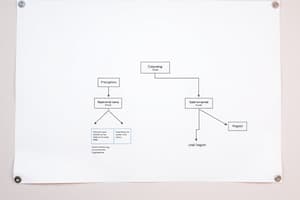Podcast
Questions and Answers
How do you show mutually exclusive conditional messages in a UML sequence diagram?
How do you show mutually exclusive conditional messages in a UML sequence diagram?
You can show mutually exclusive conditional messages in a UML sequence diagram by using a combined fragment with an 'alt' operator, indicating different alternative paths based on conditions.
What is the eventual response called in the context of asynchronous messages in UML sequence diagrams?
What is the eventual response called in the context of asynchronous messages in UML sequence diagrams?
The eventual response in the context of asynchronous messages in UML sequence diagrams is called a callback.
How are return values indicated in UML sequence diagrams?
How are return values indicated in UML sequence diagrams?
Return values in UML sequence diagrams are optionally indicated using a dashed arrow, with a label indicating the return value. However, it is not needed when it is obvious what is being returned.
When do you model a return value in a UML sequence diagram?
When do you model a return value in a UML sequence diagram?
Provide a summary of the kinds of arrows used in UML sequence diagrams.
Provide a summary of the kinds of arrows used in UML sequence diagrams.
Flashcards are hidden until you start studying
Study Notes
Object-Oriented Design using UML and Patterns: Sequence Diagrams and Messages
- The text discusses object-oriented design using UML and patterns, with a focus on sequence diagrams and messages.
- It introduces the concept of X-axis (objects) and Y-axis (members and books) with their respective interactions.
- The sequence diagram elements include Book Copy, Life Line Object, and messages like borrow(member) and setTaken(member).
- It explains how to show mutually exclusive conditional messages in the sequence diagram.
- Asynchronous messages are demonstrated with the example of ActionListener and Inventory, including addActionListener and actionPerformed.
- The eventual response to an asynchronous message is referred to as a callback.
- The text details the optional use of dashed arrows to indicate return values in sequence diagrams.
- It emphasizes modeling a return value only when it needs to be referred to elsewhere, giving an example of a parameter passed to another message.
- It summarizes the kinds of arrows used in sequence diagrams, including those indicating return values and their optional use.
- The text provides a comprehensive overview of modeling sequence diagrams and messages in object-oriented design using UML and patterns.
- It offers practical guidance on representing different types of interactions and return values within sequence diagrams.
- The information presented serves as a valuable resource for understanding and applying sequence diagrams and messages in the context of object-oriented design using UML and patterns.
Studying That Suits You
Use AI to generate personalized quizzes and flashcards to suit your learning preferences.



